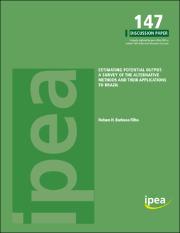Please use this identifier to cite or link to this item:
https://repositorio.ipea.gov.br/handle/11058/5450Full metadata record
| DC Field | Value | Language |
|---|---|---|
| dc.contributor.author | Barbosa Filho, Nelson H. | - |
| dc.coverage.spatial | Brasil | pt_BR |
| dc.date.accessioned | 2015-11-17T19:07:48Z | - |
| dc.date.available | 2015-11-17T19:07:48Z | - |
| dc.date.issued | 2015-01 | - |
| dc.identifier.uri | http://repositorio.ipea.gov.br/handle/11058/5450 | - |
| dc.description.abstract | Apresenta as principais questões envolvidas na estimativa do produto potencial. O objetivo é descrever os métodos alternativos e analisar sua aplicação e implicações para as previsões de crescimento e para a política macroeconômica no Brasil. O texto enfatiza os determinantes da produção potencial em coeficientes fixos e flexíveis de produção. Dada a ampla utilização de medidas agregadas de Produtividade Total dos Fatores na contabilização de crescimento, e a sensibilidade de tal variável de pressupostos econômicos e erros de medição, o texto também apresenta as principais críticas aplicadas, e alternativas para exercícios de contabilidade do crescimento agregado. | pt_BR |
| dc.language.iso | en-US | pt_BR |
| dc.publisher | Instituto de Pesquisa Econômica Aplicada (Ipea) | pt_BR |
| dc.title | Estimating potential output: a survey of the alternative methods and their applications to Brazil | pt_BR |
| dc.title.alternative | Discussion Paper 147 : Estimating potential output: a survey of the alternative methods and their applications to Brazil | pt_BR |
| dc.type | Discussion Paper | pt_BR |
| dc.rights.holder | Instituto de Pesquisa Econômica Aplicada (Ipea) | pt_BR |
| dc.source.urlsource | http://www.ipea.gov.br | pt_BR |
| dc.location.country | BR | pt_BR |
| dc.description.physical | 75 p. : il. | pt_BR |
| dc.rights.license | Reproduction of this text and the data it contains is allowed as long as the source is cited. Reproductions for commercial purposes are prohibited. | pt_BR |
| dc.subject.keyword | Produto potencial | pt_BR |
| dc.subject.keyword | Política macroeconômica | pt_BR |
| dc.subject.keyword | Previsões de crescimento | pt_BR |
| dc.subject.keyword | Produtividade Total dos Fatores (PTF) | pt_BR |
| dc.relation.references | http://repositorio.ipea.gov.br/handle/11058/1952 | pt_BR |
| ipea.description.objective | Descrever os métodos alternativos para estimativa de produto potencial, e analisar sua aplicação e implicações para as previsões de crescimento e para a política macroeconômica no Brasil. | pt_BR |
| ipea.description.additionalinformation | Série monográfica : Discussion Paper ; 147 | pt_BR |
| ipea.description.additionalinformation | Possui referências bibliográficas. | pt_BR |
| ipea.description.additionalinformation | Série: Originally published by Ipea in May 2005 as number 1092 of the series Texto para Discussão. | pt_BR |
| ipea.access.type | Acesso Aberto | pt_BR |
| ipea.rights.type | Licença Comum | pt_BR |
| ipea.englishdescription.abstract | This paper presents the main issues involved in estimating potential output. The objective is to describe the alternative methods and analyze their application and implications for growth forecasts and macroeconomic policy in Brazil. The text emphasizes the determinants of potential output under fixed and flexible coefficients of production. Given the wide use of aggregate measures of Total Factor Productivity in growth accounting, and the sensitivity of such a variable to economic assumptions and errors of measurement, the text also presents the main applied critiques and alternatives to aggregate growth-accounting exercises. The main conclusions are: i) the annual potential growth rate of Brazil’s Gross Domestic Product (GDP) varies substantially depending on the method and hypotheses adopted and, what is most important, potential GDP is not separable from effective GDP in the long-run; ii) growth-accounting and time-series studies of Brazil result in low potential-output growth rates because they extrapolate the slow growth of 1981-2003 to the future; iii) capital seems to be the main constraint on growth in Brazil and, therefore, a demand-led increase in investment can raise both its effective and potential output levels; iv) however, because of the slow adjustment of the capital stock, an investment boom can also hit a supply constraint before the stock of capital has time to adjust to the growth rate of investment; and v) aggregate measures of potential output do not carry much information about the economy and, therefore, they should be complemented by sectoral estimates of capacity utilization to identify the bottlenecks in inter-industry flows and the corresponding demand pressures on inflation. | pt_BR |
| ipea.researchfields | N/A | pt_BR |
| ipea.classification | Economia. Desenvolvimento Econômico | pt_BR |
| Appears in Collections: | Economia. Desenvolvimento Econômico: Livros | |
Files in This Item:
| File | Description | Size | Format | |
|---|---|---|---|---|
| DiscussionPaper_147.pdf | 715.04 kB | Adobe PDF |  View/Open |
Items in DSpace are protected by copyright, with all rights reserved, unless otherwise indicated.

